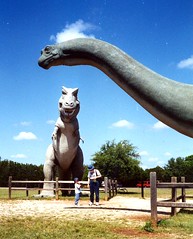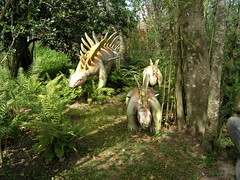 Image via Wikipedia
Image via WikipediaThese include the Tyrannosaurus Rex http://www.reuters.com/article/2011/10/13/us-science-trex-idUSTRE79B76D20111013 which is now thought to be 30% heavier, and a species of giant pterosaur, http://www.sciencedaily.com/releases/2011/10/111013085107.htmwhose wingspan has been increased to 7 meters.
 Image by Ben Rimmer via Flickr
Image by Ben Rimmer via FlickrWhy is it that these sizes have been changed after knowing of the species for so long?
There can be only one logical explanation. A conspiracy! The government thinks people will go nuts, just scared out of their minds, if we know how big the dinosaurs were all at once. And if you believe that, than I have a bridge for sale at a great discount for you!
 Image by CameliaTWU via Flickr
Image by CameliaTWU via FlickrThe real reason why this happens, according to my great wisdom, is the scarcity of the fossil record. Pretend some future race had found the fossils of 20 humans. Then they took the largest of these sets (some of which were fossils of men, women, and children) and decided that the largest set represented the maximum size of a human being. What are the chances that they actually found the largest set that has existed. Virtually nil. As more bones are uncovered, occasionally a larger specimen will be found, and the "maximum size" will be increased.
It is a very conservative approach in science that is praiseworthy in terms of not overstating the actual sizes of dinosaurs, but, it will virtually always be corrected multiple times over the years. I have two better ideas.
 Image by Getty Images via @daylife
Image by Getty Images via @daylifeSecond, and less fun, would be take the theorized measurements of all the fossils of a species that have been found so far, and place them on a standard bell curve. You should end up with most fossils in the average range, some in the small range, and some in the large range. The 99.5% number will give you a size, and that will be the maximum size of the creature.
 Image by Richard Elzey via Flickr
Image by Richard Elzey via FlickrAdvantages: Changes in the number over time will be smaller, providing more continuity and less need to revise textbooks etc. Also, this will produce larger maximum sizes almost invariably for dinosaurs. And bigger sizes are always cooler.
Disadvantages: Occasionally, some of the dinosaurs will be found to be smaller in reality than was previously hypothesized. The very small number of fossils, varied ages and genders, and questions of fossils being the same or different species may make a bell curve impossible in a lot of cases. Also, since the size of a creature based on a usually very incomplete fossil takes into account many educated guesses (the new T-rex weight is based on soft tissue measurements using crocodile and bird soft tissue averages), the "size" of any specific dinosaur fossil may change, which will then change the bell curve produced by its previous placement.
 Image by Pete Reed via Flickr
Image by Pete Reed via FlickrStill, at the end of the day, I think it's worth it, when possible, to use statistical averages to provide a more realistic and credible claim to the maximum size of extinct animals.
Related articles

No comments:
Post a Comment